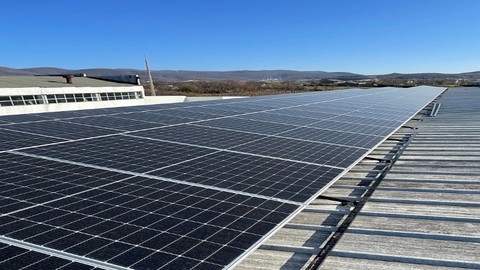
Solar Energy Foundation
Solar Energy Foundation, available at $44.99, has an average rating of 5, with 27 lectures, based on 1 reviews, and has 2 subscribers.
You will learn about Energy storage method Soil solarization Renewable heat Solar energy in rural Africa Solar power Solar updraft tower This course is ideal for individuals who are Energy consultants, managers, directors, governments, energy ministries, students, general public etc. It is particularly useful for Energy consultants, managers, directors, governments, energy ministries, students, general public etc.
Enroll now: Solar Energy Foundation
Summary
Title: Solar Energy Foundation
Price: $44.99
Average Rating: 5
Number of Lectures: 27
Number of Published Lectures: 27
Number of Curriculum Items: 27
Number of Published Curriculum Objects: 27
Original Price: $74.99
Quality Status: approved
Status: Live
What You Will Learn
- Energy storage method
- Soil solarization
- Renewable heat
- Solar energy in rural Africa
- Solar power
- Solar updraft tower
Who Should Attend
- Energy consultants, managers, directors, governments, energy ministries, students, general public etc.
Target Audiences
- Energy consultants, managers, directors, governments, energy ministries, students, general public etc.
Solar energy, radiation from the sun capable of producing heat, causing chemical reactions, or generating electricity. The total amount of solar energy incident on earth is vastly in excess of the world’s current and anticipated energy requirements.If suitably harnessed, this highly diffused source has the potential to satisfy all future energy needs. The international energy agency said that the development of affordable, inexhaustible and clean solar energy technologies will have huge longer-term benefits. It will increase countries energy security through reliance on an indigenous, inexhaustible, and mostly import- independent resources, enhance sustainability, reduce pollution, lower the cost of mitigating global warming.
The potential solar energy that could be used by humans differs from the amount of solar energy present near the surface of the planet because factors such as geography, time variation, cloud cover, and the land available to humans limit the amount of solar that we can acquire. Active solar techniques use photovoltaic, concentrated solar power, solar thermal collectors, pumps, and fans to convert sunlight into useful output. Passive solar techniques include selecting materials with favorable thermal properties, designing spaces that naturally circulate air, and referencing the position of a building to the sun. Thermal mass is any material that can be used to store heat- heat from sun in the case of solar energy. common thermal mass materials include stone, cement, and water.
Course Curriculum
Chapter 1: Introduction
Lecture 1: Introduction
Lecture 2: What is solar energy
Lecture 3: Solar radiation
Lecture 4: Electricity production
Lecture 5: Concentrated solar power
Lecture 6: Fuel production
Lecture 7: Energy storage methods
Lecture 8: Architecture and urban planning
Lecture 9: List of solar powered products
Lecture 10: Solar easement
Lecture 11: Solar tracker
Chapter 2: Solar Power
Lecture 1: What is solar power
Lecture 2: Technologies
Lecture 3: Development and deployment
Lecture 4: Economics
Lecture 5: Grid integration
Chapter 3: Renewable Heat
Lecture 1: What is renewable heat
Lecture 2: Leading renewable heat technologies
Lecture 3: Energy efficiency
Chapter 4: Soil Solarization
Lecture 1: Soil solarization
Lecture 2: Soil disinfestation
Lecture 3: Soil decontamination
Chapter 5: Solar Energy In Rural Africa
Lecture 1: Introduction
Lecture 2: Solar cooking
Lecture 3: Solar- powered water purification
Lecture 4: Solar powered drip irrigation
Chapter 6: solar Updraft Tower
Lecture 1: Solar updraft tower
Instructors
-
Eric Yeboah
MBA/ PGDip
Rating Distribution
- 1 stars: 0 votes
- 2 stars: 0 votes
- 3 stars: 0 votes
- 4 stars: 0 votes
- 5 stars: 1 votes
Frequently Asked Questions
How long do I have access to the course materials?
You can view and review the lecture materials indefinitely, like an on-demand channel.
Can I take my courses with me wherever I go?
Definitely! If you have an internet connection, courses on Udemy are available on any device at any time. If you don’t have an internet connection, some instructors also let their students download course lectures. That’s up to the instructor though, so make sure you get on their good side!
You may also like
- Best Emotional Intelligence Courses to Learn in March 2025
- Best Time Management Courses to Learn in March 2025
- Best Remote Work Strategies Courses to Learn in March 2025
- Best Freelancing Courses to Learn in March 2025
- Best E-commerce Strategies Courses to Learn in March 2025
- Best Personal Branding Courses to Learn in March 2025
- Best Stock Market Trading Courses to Learn in March 2025
- Best Real Estate Investing Courses to Learn in March 2025
- Best Financial Technology Courses to Learn in March 2025
- Best Agile Methodologies Courses to Learn in March 2025
- Best Project Management Courses to Learn in March 2025
- Best Leadership Skills Courses to Learn in March 2025
- Best Public Speaking Courses to Learn in March 2025
- Best Affiliate Marketing Courses to Learn in March 2025
- Best Email Marketing Courses to Learn in March 2025
- Best Social Media Management Courses to Learn in March 2025
- Best SEO Optimization Courses to Learn in March 2025
- Best Content Creation Courses to Learn in March 2025
- Best Game Development Courses to Learn in March 2025
- Best Software Testing Courses to Learn in March 2025






















